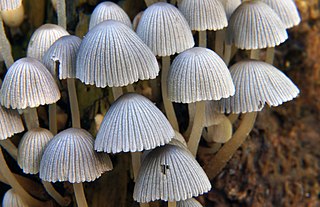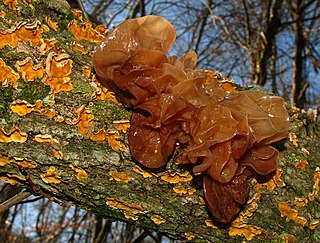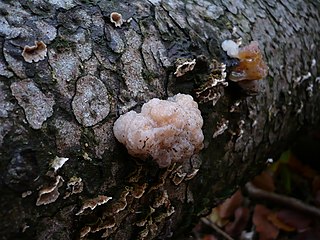
Agaricomycotina is one of three subdivisions of the Basidiomycota, and represents all of the fungi which form macroscopic fruiting bodies. Agaricomycotina contains over 30,000 species, divided into three classes: Tremellomycetes, Dacrymycetes, and Agaricomycetes. Around 98% of the species are in the class Agaricomycetes, including all the agarics, bracket fungi, clavarioid fungi, corticioid fungi, and gasteroid fungi. Tremellomycetes contains many basidiomycete yeasts and some conspicuous jelly fungi. Dacrymycetes contains a further group of jelly fungi. These taxa are founded on molecular research, based on cladistic analysis of DNA sequences, and supersede earlier morphology-based classifications. Agaricomycotina contains nearly one third of all described species of fungi.

The Tremellomycetes are a class of dimorphic fungi in the Agaricomycotina. Some species have gelatinous basidiocarps or (microscopically) a sacculate parenthesome. There are six orders, 17 families, and 39 genera in the Tremellomycetes. Tremellomycetes include yeasts, dimorphic taxa, and species that form complex fruiting bodies. Tremellomycetes include some fungi that are human and animal pathogens in the genera Cryptococcus, Naganishia, Papiliotrema, and Trichosporon and some fungi that are cultivated for food in the genera Tremella and Naematelia.

The Tremellaceae are a family of fungi in the order Tremellales. The family is cosmopolitan and contains both teleomorphic and anamorphic species, most of the latter being yeasts. All teleomorphs in the Tremellaceae are parasites of other fungi, though the yeast states are widespread and not restricted to hosts. Basidiocarps, when produced, are gelatinous.
The Cystofilobasidiales are an order of fungi in the class Tremellomycetes of the Basidiomycota. They usually exhibit a life phase of free-living yeasts. The order contains two families with seven genera and some 25 species.

The Tremellales are an order of fungi in the class Tremellomycetes. The order contains both teleomorphic and anamorphic species, most of the latter being yeasts. All teleomorphic species in the Tremellales are parasites of other fungi, though the yeast states are widespread and not restricted to hosts. Basidiocarps, when produced, are gelatinous.
The Cuniculitremaceae are a family of fungi in the order Tremellales. There are three genera in the family. Sterigmatosporidium polymorphum parasitizes other fungi growing in insect galleries in wood. It does not produce basidiocarps, but has septate basidia similar to those found in the genus Tremella. Most species are known only from their yeast states.

Tremella is a genus of fungi in the family Tremellaceae. All Tremella species are parasites of other fungi and most produce anamorphic yeast states. Basidiocarps, when produced, are gelatinous and are colloquially classed among the "jelly fungi". Over 100 species of Tremella are currently recognized worldwide. One species, Tremella fuciformis, is commercially cultivated for food.
Bullera is a genus of fungi in the family Bulleraceae. The genus, which comprises both anamorphic and teleomorphic forms, formerly contained some 35 species. Molecular research, based on cladistic analysis of DNA sequences, has however assigned most of these species elsewhere and reduced the genus Bullera to just four species. Anamorphic forms are yeasts; teleomorphic forms produce septate basidia resembling those of Tremella species, but are not known to produce basidiocarps.

Phaeotremella is a genus of fungi in the family Phaeotremellaceae. All Phaeotremella species are parasites of other fungi and produce anamorphic yeast states. Basidiocarps, when produced, are gelatinous and are colloquially classed among the "jelly fungi". Fifteen or so species of Phaeotremella are currently recognized worldwide. Tremella sanguinea, shown to be a Phaeotremella species by DNA sequencing, is cultivated in China as an ingredient in traditional Chinese medicine.

Phaeotremella frondosa is a species of fungus in the family Phaeotremellaceae producing brownish, frondose, gelatinous basidiocarps. It is widespread in north temperate regions, and is parasitic on other species of fungi that grow on dead attached and recently fallen branches of broadleaf trees.

Phaeotremella foliacea is a species of fungus in the family Phaeotremellaceae. It produces brownish, frondose, gelatinous basidiocarps and is parasitic on the mycelium of Stereum sanguinolentum, a fungus that grows on dead attached and recently fallen branches of conifers. It is widespread in north temperate regions. In the UK it has the recommended English name leafy brain and has also been called jelly leaf and brown witch's butter. Prior to 2017, the name Tremella foliacea was also applied to similar-looking species on broadleaf trees, now distinguished as Phaeotremella frondosa and Phaeotremella fimbriata.
The Holtermanniales are an order in the fungal class Tremellomycetes. The order contains two genera. Species of Holtermannia produce groups of horn-like gelatinous basidiocarps on wood and have associated yeast states. Species of Holtermaniella are only known as yeasts.

Naematelia is a genus of fungi in the family Naemateliaceae. All Naematelia species are parasites of other fungi and produce anamorphic yeast states. When produced, Basidiocarps ,, are gelatinous and are colloquially classed among the "jelly fungi."Four species of Naematelia are currently recognized worldwide. One species, Naematelia aurantialba, is commercially cultivated for food.

Naematelia aurantia is a species of fungus producing yellow, frondose, gelatinous basidiocarps. It is widespread in north temperate regions and is parasitic on another species of fungus that grows on dead attached and recently fallen branches of broadleaf trees. It is commonly called golden ear in North America.
Pseudotremella is a genus of fungi in the family Bulleraceae. All Pseudotremella species are parasites of other fungi and produce anamorphic yeast states. Basidiocarps, when produced, are gelatinous and are colloquially classed among the "jelly fungi". Four species of Pseudotremella are currently recognized worldwide. Two of these species are, as yet, only known from their yeast states.
The Bulleraceae are a family of fungi in the order Tremellales. The family currently contains five genera. Some species produce gelatinous basidiocarps and were formerly placed in the genus Tremella. Most, however, are only known from their yeast states.
Solicoccozyma is a genus of fungi in the family Piskurozymaceae. Species have only been isolated in their yeast states, several of which were formerly referred to the genus Cryptococcus, but can produce filamentous states with basidia in culture. Nine species have been described worldwide.
The Trichosporonales are an order in the fungal class Tremellomycetes. The order contains two families and ten genera. Several species in the Trichosporonaceae are human pathogens.
Tremella yokohamensis is a species of fungus in the family Tremellaceae. It produces white, foliaceous, gelatinous basidiocarps and is parasitic on other fungi on dead wood of broad-leaved trees. It was originally described from Japan.
Tremella exigua is a species of fungus in the family Tremellaceae. It produces small, dark, pustular, gelatinous basidiocarps and is parasitic on pyrenomycetous fungi on dead branches of trees and shrubs. It was originally described from France.










